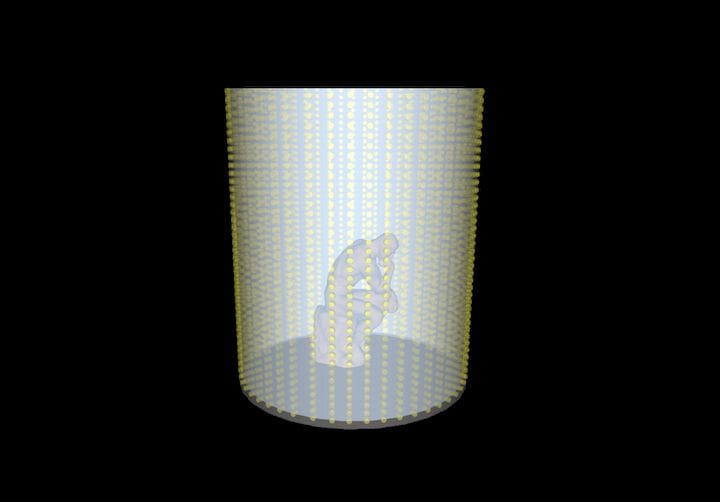![Concept for an Electric 3D Printing process [Source: RepRap Ltd]](https://fabbaloo.com/wp-content/uploads/2020/05/image-asset_img_5eb09350aeb2a.jpg)
Researcher Adrian Bowyer has proposed a near-unbelievable electric 3D printing concept that could revolutionize making in future decades.
Bowyer should be a very recognizable name to Fabbaloo readers, as he was one of the main proponents behind the RepRap initiative over ten years ago. That project developed the open source designs for the first inexpensive desktop 3D printers, which countless entrepreneurs leveraged to become what are today’s large 3D printer manufacturers.
Meanwhile, Bowyer is still developing improvements to basic 3D printing processes, and even entirely new concepts as described in this story.
It’s said that new ideas are often simply combinations of previous ideas that hadn’t been brought together previously, and this is a classic case of that approach. Here, Bowyer seems to have added 2 + 2 + 2 to get, well, 100 — or, as he calls it, “Electric 3D Printing”.
He’s combined three recent 3D printing technological developments together to propose an unusual 3D printing process concept that in theory could print objects near-instantly in a wide variety of materials, including metals. If that sounds impossible, it is certainly so today, but have a listen to what Bowyer proposes and your mind might be changed about the future.
The three developments he’s combined include:
Reverse CT-scan 3D printing process: In a process we reported on some time ago, Berkeley/Livermore researchers realized that the normal 3D scan process could be reversed to enable high-speed 3D printing by rotating a cylinder of photopolymer resin and repeatedly exposing it to differently-angled images of the desired object.
Electric 3D scanning technique: Spectra researchers realized they could perform a kind of “x-ray” 3D scanning technique by obtaining electrical resistance measurements between many points alongside a subject object.
Electropolymerization: Researchers discovered a way to use electricity to polymerize a monomer in much the same way that photons are used to solidify photopolymer resin. In other words, use electricity instead of photons.
Instant 3D Printing
Now his concept is to combine these approaches together. Let’s let Bowyer describe the resulting apparatus:
“My idea is to have a bath of monomer engineered to polymerise using an electric current. In place of shining light through it like the Berkeley/Livermore system, the current is programmed using the reverse of the Spectra system. In its final form, one would have a cylindrical bath containing the liquid monomer. The walls of the bath would have a fine array of electrodes in a square grid over their entire area. These would be addressed by a controlling computer to pass electric currents through the liquid monomer in such a way as to solidify it just where required to form the 3D solid defined by an STL file (as in conventional 3D printing). The machine would have no moving parts, and the solid would be formed in (I hope) a few seconds.”
What hit me was that last sentence, which is definitely worth reading again:
“The machine would have no moving parts, and the solid would be formed in (I hope) a few seconds.”
Instant Metal 3D Printing
Wait! It gets better:
“Finally, and very speculatively, an even more ambitious possibility would be to move from organic chemistry to inorganic, and to replace the bath of monomer with an electrolyte such as copper acetate or copper sulphate. It might then be possible to cause the copper to precipitate at any location in 3D space if the pattern of electric currents through the liquid could be got right. The dense copper would settle out of solution, of course, so the process would have to start at the bottom of the bath and work up.
If it could be made to work, we could then 3D-print a complete solid copper object at room temperature. Or, for that matter, a titanium one…“
Note that the metal objects produced in this way would be pure metal and not require a post-print sintering process as do other cold metal 3D printing processes do.
I have so many questions, and so much hope for this approach.
As you can imagine, there are multiple technical challenges to make the electric 3D printing process actually work, and of course researchers should begin sorting them out as soon as possible.
Mass 3D Printing
If electric 3D printing becomes real, then the world of 3D printing could be in for a very dramatic shakeup.
A machine that prints multiple materials near-instantly is a game-changing technology that would essentially make existing equipment — and associated manufacturers — obsolete. That’s because it would break one of the toughest barriers to 3D print technology adoption: long print times.
Long print times are far more than just annoying; they imply the technology cannot be used for mass production. Today, if you wanted a million parts you would have little choice as to which making technology to use: traditional processes of injection molding, stamping, etc.
But what if there were another technology that could make just as many in the same time? The time barrier is also a major part of the mass manufacturing barrier.
Bowyer could have just come up with a trillion dollar idea.
Via RepRap Ltd












1 comment
Comments are closed.